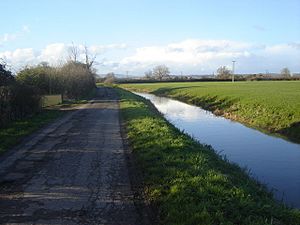Caldicot and Wentloog Levels facts for kids

The Caldicot and Wentloog Levels are two large areas of flat, low land in south east Wales. They are found near Newport, next to the Severn Estuary. This is where the River Usk meets the sea. People sometimes call these areas the Monmouthshire Levels or Gwent Levels.
The Caldicot Level is to the southeast of Newport. It stretches between the River Usk and the River Wye. This area is about 17,500 acres (71 km2) big. It is home to the Newport Wetlands Reserve, a special place for wildlife.
The Wentloog Level is to the southwest of Newport. It lies between the River Usk and the Rhymney River. This part is about 8,500 acres (34 km2) in size.
These flat lands were made from mud and sand brought in by the tides. Over many years, people have worked to reclaim this land from the sea. They have done this since Roman times. Because of this, the Levels are full of amazing archaeological finds. These finds show how people lived here long ago. They include items from the Mesolithic, Bronze Age, and Iron Age periods.
The Levels are also a very important wetland area. Some parts are protected as Sites of Special Scientific Interest. This means they are special places for nature. The area is also known as a Historic Landscape. This shows its important history in Wales.
History and amazing finds
The land and sea levels in the Severn Estuary have changed a lot over thousands of years. People have lived here for a very long time. The Levels have been reclaimed from the sea at different times. This has helped to save clues about how people lived, built homes, and drained the land.
Scientists have found very old remains at Goldcliff. These include items from the Mesolithic period. Even human footprints from the late Mesolithic period have been found at Uskmouth.
One of the most exciting discoveries was a Roman boat. It was found at Wilcrick near Magor. This boat was from the 3rd century AD. The Romans lived in this area from the 2nd to the 4th centuries. In 1878, a special stone was found at Goldcliff. It showed that Roman soldiers built 33 paces of a sea wall.
At first, people started farming on small "island" areas in the marshes. Places like Nash and Redwick were some of these early settlements. Later, a long sea wall was built along the entire coast. This helped to protect more land from the sea.
Goldcliff Priory was a monastery built in 1113. The monks and other big landowners helped with more drainage work. Villages grew, connected by old paths called droveways. One famous path is the Whitewall at Magor. More and more land was used for farming and raising animals. Many Anglo-Norman buildings show that people lived here all through the Middle Ages. These include castles, churches, and manor houses.
A huge flood hit the Bristol Channel on January 30, 1607. This was caused by a very high tide or a tsunami. About 2,000 people lost their lives. Many houses and villages were washed away. Around 200 square miles (520 km2) of farmland were flooded. Many farm animals also died. This was one of the worst natural disasters ever recorded in Britain.
How the land is managed
Most of the Caldicot and Wentloog Levels have special drainage systems. The area has many small channels called 'reens'. These reens help to drain water away from the land. Many of them are looked after by the Caldicot and Wentlooge Levels Internal Drainage Board.
In 1531, Henry VIII set up Courts of Sewers. These groups were meant to help improve drainage. Later, in 1884, a new group was created. It was called the Monmouthshire Commissioners of Sewers. Their job was to keep the sea walls and roads in the Levels in good condition.
Today, the Internal Drainage Board (IDB) manages the drainage. They make sure the reens and sea walls protect the land. The way the ditches are set up on the Caldicot Level has changed. This is because of the Newport Wetlands Reserve. Before, all ditches were made to drain water away. But at the reserve, new waterways were built to keep the land wet. This helps the wildlife that lives there.
Amazing wildlife
The Caldicot and Wentloog Levels are home to many rare and special animals and plants. Here are some of them:
- Variable damselfly (Coenagrion pulchellum) – a beautiful insect that looks like a small dragonfly.
- Flowering rush (Butomus umbellatus) – a unique plant that grows near water. It has lovely pink flowers in May and June.
- Lapwing (Vanellus vanellus) – a striking bird with a crest on its head.
- Musk beetle (Aromia moschata) – a shiny green beetle with a strong smell. It lives in willow trees along the reens.
- Great silver water beetle (Hydrophilus piceus) – one of Britain's biggest beetles. It lives in the water.
- Water vole (Arvicola terrestris) – a small rodent that lives near water. They are sometimes called "water rats."

